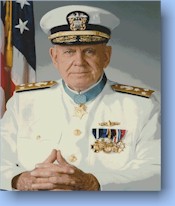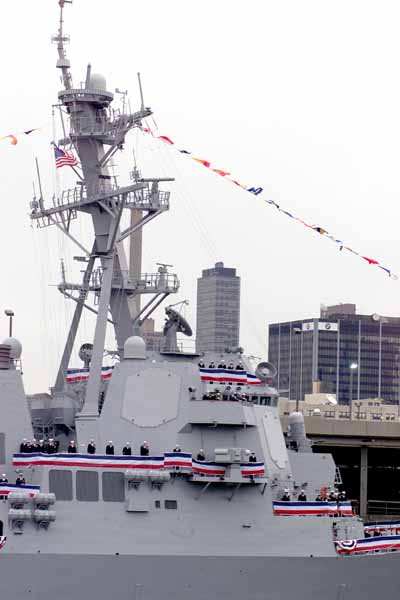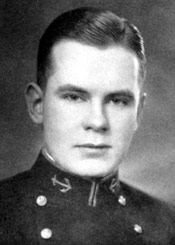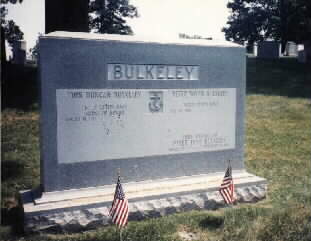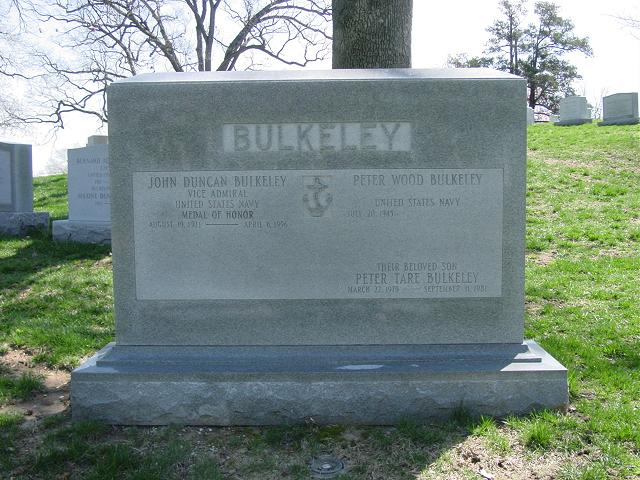On June 24, 2000, Joan Bulkeley State of Oak Brook will join family members and Naval personnel for the christening of a Navy destroyer in honor of her father, the late Vice Adm. John Duncan Bulkeley. The christening of the ship will take place in Pascagoula, Miss. Petitions to name a ship in honor of Bulkeley were initiated from the men who served under him throughout his military career. “The many men who served under him really wanted to see this happen, especially the men of the ship the Endicott,” said Bulkeley Stade.
Bulkeley’s distinguished military career began when he graduated from the Naval Academy in 1933. He was decorated with the Congressional Medal of Honor for his many actions, which included the rescue of General Douglas MacArthur, his family and staff from Corregidor in 1942, by way of motor torpedo boat. Bulkeley’s leadership during that experience in the Philippines has been immortalized in the movie “They Were Expendable.” John Ford directed the film that starred Robert Montgomery as Bulkeley; the cast also includes John Wayne, Ward Bond and Donna Reed.
At the age of 32, Bulkeley commanded more than 17,000 troops during the D-Day invasion. Bulkeley participated in the 50-Year Memorial of the D-Day invasion off the coast of Normandy where he reminded all in attendance that the true heroes of World War II were the ones who did not return.
Bulkeley was in command of Guantanamo Bay in the early 1960s. “At one point during his command there, he had a giant shield of the Marine insignia illuminated with flood lights as a reminder of American presence on Cuba. The shield is still intact today,” said Bulkeley Stade.
When Bulkeley passed away four years ago, he was one of the most decorated Naval officers and was buried with full military honors at Arlington National Cemetery.
In addition to the Congressional Medal of Honor, his decorations include the Navy Cross, two Distinguished Service Crosses, Distinguished Service Medal, two Silver Stars, two Legion of Merits and the Croix de Guerre, France’s highest military honor.
“Dad always said he only did what any American would do, he was very humble,” Stade said.
Born in New York City on August 19, 1911, he graduated from the Naval Academy in 1933. He served tours on the USS Saratoga, USS Indianapolis and USS Sacramento. By 1941, he had advanced to the rank of Lieutenant. In February of that year he took command of Submarine Chaser Division One, and in September was ordered to the Philippines in command of Motor Torpedo Squadron Three, consisting of six vessels.
When the initial Japanese attacks of December 8, 1941 (December 7 in Hawaii) ended, nearly all Navy air forces in the Philippines had been destroyed and much of what survived was ordered out shortly thereafter. Defense of the islands was assigned to a few P-40 aircraft and his PT boats, a task made seemingly impossible by the lack of spare parts, repair facilities and fuel. By sheer determination and infenity, he kept his squadron operational for more than four months under these conditions, repelling Japanese landing parties, destroying great numbers of transports, armed cruisers and aircraft, and even operating against land forces.
When U.S. ground forces had withdrawn onto the Bataan Peninsula and the situation had become desperate, Squadron Three made a daring dash out of Manila Harbor on the night of March 11, 1942, bearing General of the Army Douglas MacArthur and a small party to safety. Squadron Three then continued to operate in Philippine waters until April. For gallantry and leadership he was awarded the Medal of Honor.
Promoted to Lieutenant Commander, he took part in the landings in Trobiand Islands in July 1943. He then commanded PT boats patrolling the beaches during the Allied landing on the beaches of Normandy in the Atlantic Theater of Operations. At the landing of General Alexander M. Patch’s 7th Army by Admiral J. Kent Hewitt’s Western Naval Task Force on the South coast of France on August 15, 1944, then a Commander, he was captain of the destroyer USS Endicott, which sank two German corvettes attempting to escape from the harbor at Toulon.
He remained in the Navy after the war, rising to the rank of Rear Admiral in June 1963, the same year that he was named commander of the Navy Base at Guantanamo, Cuba. In 1967, he became President of the Navy’s Board of Inspection and Survey. He retired from active duty as a Vice Admiral in 1975.
He was then recalled to active duty and retired again in 1988 at the age of 78.
A US Navy Destroyer, USS Bulkeley (DDG 84) is named after the Admiral and is to be commissioned in New York in 2001 and homeported in Norfolk, Virginia.
He died on April 6, 1996 and is buried in Section 5 of Arlington National Cemetery.
BULKELEY, JOHN DUNCAN
Rank and organization: Lieutenant Commander, Commander of Motor Torpedo Boat Squadron 3, U.S. Navy. Place and date: Philippine waters, 7 December 1941 to 10 April 1942. Entered service at: Texas. Born: 19 August 1911, New York, N.Y. Other awards: Navy Cross, Distinguished Service Cross, Silver Star, Legion of Merit.
Citation
For extraordinary heroism, distinguished service, and conspicuous gallantry above and beyond the call of duty as commander of Motor Torpedo Boat Squadron 3, in Philippine waters during the period 7 December 1941 to 10 April 1942. The remarkable achievement of Lt. Comdr. Bulkeley’s command in damaging or destroying a notable number of Japanese enemy planes, surface combatant and merchant ships, and in dispersing landing parties and land-based enemy forces during the 4 months and 8 days of operation without benefit of repairs, overhaul, or maintenance facilities for his squadron, is believed to be without precedent in this type of warfare. His dynamic forcefulness and daring in offensive action, his brilliantly planned and skillfully executed attacks, supplemented by a unique resourcefulness and ingenuity, characterize him as an outstanding leader of men and a gallant and intrepid seaman. These qualities coupled with a complete disregard for his own personal safety reflect great credit upon him and the Naval Service.
December 6, 2001
(703)697-5737(public/industry)
NAVY TO COMMISSION GUIDED MISSILE DESTROYER BULKELEY
The Department of the Navy will commission the Arleigh Burke class guided missile destroyer Bulkeley in a ceremony Saturday, December 8, 2001, at 11 a.m. EST at the Intrepid Sea, Air and Space Museum, Pier 88, in New York City.
The ship is named in honor of Navy Vice Adm. John Duncan Bulkeley, (1911-1996), recipient of the Medal of Honor, Navy Cross, and numerous other decorations for heroic actions during World War II. While in command of Motor Torpedo Boat (MTB) Squadrons Three and Seven during the defense of the Philippines, Bulkeley evacuated Army Gen. Douglas MacArthur and President Quezon of the Philippines, and destroyed several Japanese planes, surface combatants, and merchant ships. As commander of MTB Squadron 102, he supported the Normandy and Southern France invasions. Following the war, he became president of the Board of Inspection and Survey, where he continued to serve upon transfer to the retired list on January 1, 1974.
Deputy Secretary of Defense Paul Wolfowitz will deliver the ceremony’s principal address. Serving as the ship’s sponsors are Bulkeley’s three daughters, Regina Day, Joan Stade, and Diana Lindsay, a daughter-in-law, Carol A. Bulkeley, and Sarah Fargo, wife of U.S. Pacific Fleet Adm. Thomas B. Fargo. In the time-honored Navy tradition, the sponsors will give the order to “bring our ship to life!”
Bulkeley is the 34th of 58 Arleigh Burke class destroyers currently authorized by Congress, and the 15th of this class to be built by Northrop Grumman Ship Systems Ingalls Operations in Pascagoula, Miss. Arleigh Burke class destroyers are the most capable surface warships ever built. Truly multi-mission combatants, these ships can conduct a variety of operations, from peacetime presence and crisis management to sea control and power projection, in support of the National Military Strategy.
Equipped with the latest weapons, electronics, helicopter support facilities, propulsion, auxiliary and survivability systems, DDG 51 destroyers will carry out the Navy’s missions well into the 21st century. State-of-the-art command, control, communications, computers and intelligence systems provide the ships’ crew with complete situational awareness.
Bulkeley is also equipped with the Navy’s modern Aegis combat weapons system, the world’s foremost naval weapon system. Space-age communications, radar and weapons technologies are combined in a single platform for unlimited mission flexibility. The systems include the AN/SPY-1D phased array radar, the MK 41 Vertical Launching System, which fires a combination Standard surface-to-air, and Tomahawk surface-to surface missiles, and the AN/SQQ-89 Antisubmarine Warfare System, with a bow mounted AN/SQS-53C sonar.
In addition, Bulkeley has six MK 46 torpedo tubes, two MK 15 Phalanx Close-In Weapons Systems, and a multi-mission 5″/62 caliber deck-mounted gun which can be used as an anti-ship weapon, close-in point defense or for support of forces ashore with naval gunfire.
The ship’s aircraft handling and support facilities include dual aircraft hangers, a dual Recovery Assist, Securing and Traversing System, and associated machinery systems providing significant enhanced helicopter launch and recovery, command and control and maintenance/repair capabilities. The ship also features the over-the-horizon LAMPS MK III Antisubmarine Warfare Control System, and will be assigned two SH-60B Seahawk undersea warfare helicopters.
Cmdr. Carlos Del Toro, a native of Havana, Cuba, raised in New York City, is the commanding officer of Bulkeley. With a crew of approximately 380 officers, chiefs and enlisted personnel, Bulkeley will be homeported in Norfolk, Va., as a member of the U.S. Atlantic Fleet. Bulkeley is 509.5 feet in length, and has a waterline beam of 59 feet. Four gas-turbine engines power the 9,300 ton ship to speeds in excess of 30 knots.
By Rudi Williams
American Forces Press Service
10 December 2001
They called him the “Sea Wolf” for his daring World War II exploits in Europe and the Pacific. He’s a Navy legend and the recipient of the Medal of Honor, Navy Cross and several other medals for heroism.
The Navy and the nation immortalized his name on December 8 with the commissioning of the USS Bulkeley, the newest Arleigh Burke-class guided missile destroyer. The ship is named in honor of Vice Admiral John Duncan Bulkeley who died in April 1996 at age 84. He served on active duty for more than 55 years.
Keynote speaker Deputy Defense Secretary Paul Wolfowitz said immediately after the September 11 terrorist attack on the World Trade Center, New York City officials considered canceling the commissioning ceremony out of concern for the protection of the ship, her crew and the audience.
“But it’s easy to imagine what John Bulkeley would have said about that…,” Wolfowitz said. “Pass up a chance to see a ship of the United States Navy come to life in defiance of those who want to take life and freedom away? Move this ceremony? ‘Not on your life!’ he would surely say.
“There is no more fitting place to commission this ship, here within the shadow of Lady Liberty and within walking distance of ‘Ground Zero,'” he said. “In doing so, we can help to honor the tough old ‘Sea Wolf,’ who repeatedly showed throughout his career that he was not afraid to stand up to anyone who threatened our freedom.”
In citing some of Bulkeley’s wartime exploits, Wolfowitz said in the first weeks of World War II, with most of the Pacific fleet wiped out and nothing but bad news coming from the Pacific, then Lt. Bulkeley and his men changed all that when they sank a Japanese cruiser.
“And they kept up the fight,” the deputy secretary said. “With little to no spare parts, ammunition or food, their motor torpedo boats repeatedly and unhesitatingly attacked Japanese ships in the Philippines. (They sustained) their operations for four months and seven days with almost no support except their own ingenuity and daring.”
With Corregidor Island under siege in Manila Bay and Japanese forces closing in, Bulkeley’s PT boat spirited Gen. Douglas MacArthur, his family and the president of the Philippines through 600 miles of seas infested with enemy warships, Wolfowitz noted.
“By MacArthur’s own reckoning, they snatched him, the commander of the U.S. Forces, ‘out of the jaws of death,'” he said. “That heroic action in the Pacific earned the young sailor the Medal of Honor, the admiration of our nation, and a ticker tape parade here in his hometown, right down Broadway. A crowd of more than a million people turned out to honor Lieutenant Bulkeley and his crew.”
Bulkeley continued his exploits as commander of the destroyer USS Endicott in the European theater. “A month after D-Day, with only one of Endicott’s guns working, he attacked two German corvettes at point-blank range and sank them both,” Wolfowitz told the huge audience. “Afterwards he said, ‘as long as we had even one gun left, I was going to attack. That’s what’s expected of a United States Navy officer and warship.'”
Then in 1963, Bulkeley took that same toughness to Cuba, where he faced off with Fidel Castro while commanding Guantanamo Naval Base. “He cut the water line that Castro had turned off, and vowed that we would never again depend on Cuba as a water source,” Wolfowitz said. “To this day, we don’t.”
Not only was Bulkeley a combat hero, he was a hero for sailors and Marines. In one example, he insisted that emergency escape breathing devices be installed on every ship in the fleet.
“He lived to see the difference it made when the frigate USS Stark came under Iraqi missile attack in the Persian Gulf in 1987,” the secretary said. “Thirty-seven sailors perished in that tragedy, but many more would have died from the smoke and flames were it not for the breathing devices that John Bulkeley had put on board.
“There is no doubt that this man helped save countless lives — it is a legacy that extends to the sailors and Marines who will man the USS Bulkeley today,” Wolfowitz noted.
Wolfowitz pointed out that the USS Bulkeley’s commander, Commander Carlos Del Toro left communist Cuba as a child, came to this country, attended the Naval Academy, and rose through the ranks to take command of the Navy’s newest destroyer.
“That story is in itself a testament to the promise of our nation and to Carlos Del Toro’s own tough, fighting spirit,” Wolfowitz said.
New York Mayor Rudy Giuliani traced the city’s maritime tradition from the American Revolution to the present day. He said the Navy’s first steamship was built there in 1814. The Monitor, which arguably became the most famous Union Navy ship of the Civil War, was built in Brooklyn in 1862. During World War II, Staten Island was home to a major destroyer shipyard. The Brooklyn Navy Yard produced many battleships, aircraft carriers and cruisers, he said.
“Many of the great ships of the 20th century made their maiden voyage through the waters of New York Harbor,” Giuliani said.
“Today, one of the great ships of the 21st century will begin that same voyage. When the USS Bulkeley sets sail down the Hudson River, passing the Statue of Liberty, before the open waters of the Atlantic Ocean, she will be sailing through one of our nation’s most historic waters. Like each of the Navy ships that sailed before her, she sails to protect our way of life, and our foundation of liberty and justice,” the mayor said.
BULKELEY, JOHN DUNCAN
- VADM US NAVY
- DATE OF BIRTH: 08/19/1911
- DATE OF DEATH: 04/06/1996
- BURIED AT: SECTION 5 SITE 129-9 LH
ARLINGTON NATIONAL CEMETERY
BULKELEY, HILDA ALICE
- DATE OF BIRTH: 11/19/1912
- DATE OF DEATH: 03/16/2008
- BURIED AT: SECTION 5 SITE 129-9 LH
- ARLINGTON NATIONAL CEMETERY
- WIFE OF BULKELEY, JOHN DUNCAN, VADM, US NAVY
Michael Robert Patterson was born in Arlington and is the son of a former officer of the US Army. So it was no wonder that sooner or later his interests drew him to American history and especially to American military history. Many of his articles can be found on renowned portals like the New York Times, Washingtonpost or Wikipedia.
Reviewed by: Michael Howard

